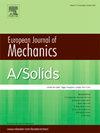微力学生物学:力学生物学的微力学方法
IF 4.2
2区 工程技术
Q1 MECHANICS
引用次数: 0
摘要
本文的主旨是沿着微力学的微-中观-宏观路线提出一条可能的路线,为充满活力的力学生物学领域做出贡献。我们特别关注机械转导:细胞适应环境的机制,以及它的失败如何成为包括癌症在内的许多疾病的关键。本文从其与开孔泡沫的几何相似性出发,总结了目前对生物聚合物网络作为力学转导中心实体的力学行为的理解。更具体地说,我们讨论了核膜中的分子网络动力学,细胞骨架中的丝状网络,以及构成细胞外基质的网络。我们强调,这些网络的行为丰富度的增强源于熵的相对较大的贡献。我们还确定了由于所涉及的材料本质上是动态和活跃的这一事实而产生的一些挑战。解决这些挑战所需工具的开发才刚刚开始,因此为当前和新一代的微机械师提供了光明的未来。本文章由计算机程序翻译,如有差异,请以英文原文为准。
Micromechanobiology: A micromechanics approach to mechanobiology
The thrust of this article is to postulate a possible route along the micro-meso-macro lines of micromechanics to contribute to the vibrant field of mechanobiology. In particular, we focus on mechanotransduction: the machinery by which cells adapt to their environment and how its failure is key to many diseases, including cancer. Starting out from the geometrical similarity with open-cell foams, for which the micro-meso-macro transition is well developed, this paper summarizes the current understanding of the mechanical behavior of biopolymer networks as central entities in mechanotransduction. More specifically, we address the dynamics of molecular networks in the nuclear membrane, filamentous networks in the cytoskeleton, as well as networks making up the extracellular matrix. We emphasize that the enhanced richness in behavior of these networks originates from the relatively large contribution of entropy. We also identify a number of challenges arising from the fact that the materials involved are intrinsically dynamic and active. The development of tools needed to address these challenges has just started and thus offers a bright future for current and new generations of micromechanicians.
求助全文
通过发布文献求助,成功后即可免费获取论文全文。
去求助
来源期刊
CiteScore
7.00
自引率
7.30%
发文量
275
审稿时长
48 days
期刊介绍:
The European Journal of Mechanics endash; A/Solids continues to publish articles in English in all areas of Solid Mechanics from the physical and mathematical basis to materials engineering, technological applications and methods of modern computational mechanics, both pure and applied research.

 求助内容:
求助内容: 应助结果提醒方式:
应助结果提醒方式:


